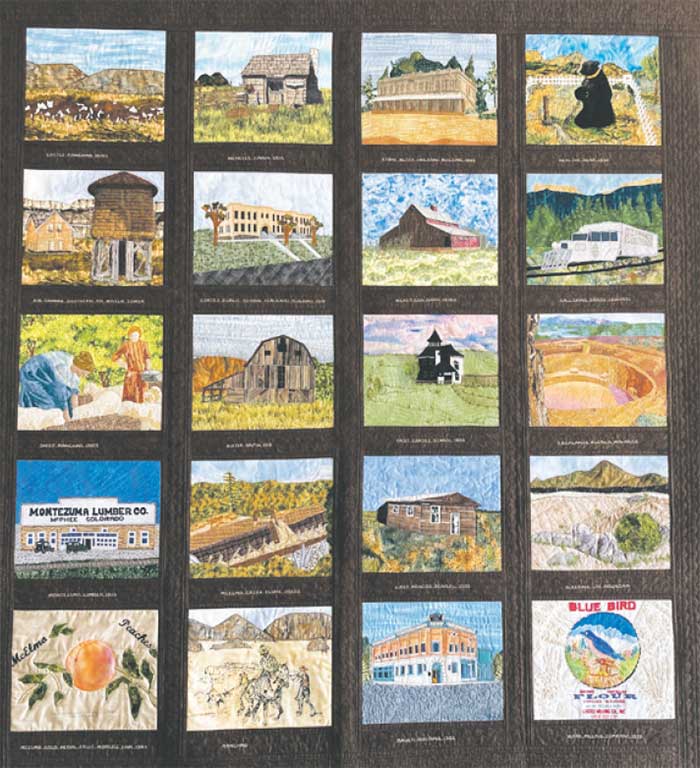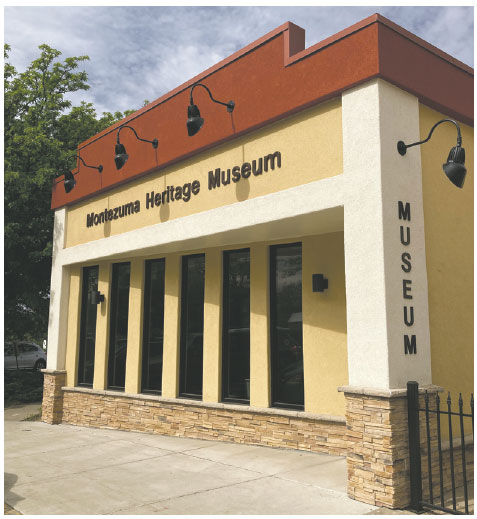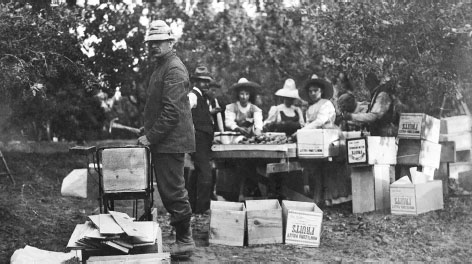
A locally crafted quilt hanging in the new Montezuma Heritage Museum in Cortez depicts scenes from the area’s history. The museum is tentatively scheduled to open this fall. Photo by Janneli Miller
“Those who don’t know history are destined to repeat it.”
— Edmund Burke (1729-1797) British philosopher
“Those who cannot remember the past are condemned to repeat it.”.
— George Santayana (1863-1952) American philosopher born in Spain
“Those that fail to learn from history, are doomed to repeat it
— Winston Churchill (1874-1965)
This oft-quoted idea has many attributions besides those cited above. Whether it would be doom, condemnation or destiny is uncertain, but a dedicated group of Montezuma County residents are determined that local residents will not be repeating the past.
The finishing touches are being put on the former Montgomery Ward building at 35 S. Chestnut, the home of the new Montezuma Heritage Museum in Cortez. Interested residents were given a “sneak peek” on May 22 as a part of the 11th Annual Cortez Historic Preservation Day activities.
The museum will serve to educate and inform visitors about the historical heritage of Montezuma County – so the past will not be forgotten.
The idea for a local history museum has been kicking around the region for a while. No one can really remember when or who originally thought of the idea, said Barbara Stagg, museum development director.
However, the idea for a museum is clearly a result of the work of the Montezuma County Historical Society, which, according to their most recent newsletter, “has been working for several decades to educate, enrich and inspire our residents and visitors through the preservation, presentation and interpretation of the county’s rich and diverse history.”
Historical Society Chairwoman Ann Wilson Brown explained that the “history museum will add to the cultural and economic life of this place we all love.”
“My heart is just so full with all the community support we’ve had,” she said.
The museum is the result of concerted efforts by many community members who have been involved in fundraising, building renovation, exhibit planning, and even quilting! A feasibility study was conducted in 2018, which indicated that the community would support the effort, and that year Montezuma County Commissioners Keenan Ertel, Larry Don Suckla and James Lambert approved the donation of the 4,800-square-foot building – which used to be the Social Services building – to the historical society on a no-charge lease.
The Save Our History-Tell Our Stories capital campaign began in 2019 with a generous donation from Robert Longenbaugh, who died in October 2020 at the age of 84. Longenbaugh was a descendant of original pioneer families, growing up in Cortez and learning how to irrigate with a shovel when he was 8, in the early 1940s.
His father was Harry Longenbaugh, which is also an alias used by the notorious robber Sundance Kid – who is thought to have lived and worked on a ranch near CR 23 and L. Robert’s father was not Sundance, yet perhaps the name helped foster his lifetime interest in the area. He told museum staff that Montezuma County and its people were dear to him and helping to make the dream of a historical museum come true meant the world to him.
The capital campaign, co-chaired by Joe Keck and Ed Merritt, had a goal of $350,000, and at press time over $380,000 had been raised. This includes a challenge grant from Colorado Housing & Finance Authority, as well as other grants from the Colorado Department of Local Affairs, USDA Rural Development, Onward! A Legacy Foundation, and El Pomar Foundation, plus donations from the Gates Foundation, many local banks and businesses, and more than 200 individuals. As of May 21, 38 percent of funds raised were from individual gifts, 56 percent were grants and the rest came from corporations, businesses and City of Cortez grants.

The Montezuma Heritage Museum is located in the old Montgomery Ward Building at 35 S. Chestnut, Cortez. Photo by Janneli Miller
More money was needed because of some necessary “hidden” building renovations and increased costs of building supplies. Lumber prices have risen as much as 50 percent since April 2020, according to the Bureau of Labor Statistics.
The pandemic also put a halt to museum fundraising efforts, according to Stagg, who told the Free Press that “we took a break from fundraising because of the human needs of the non-profits due to the pandemic.” She said the museum didn’t want to compete for funds when so many were in need of essential services.
Fundraising efforts also included the Montezuma History Quilt completed by the Blocks Without Borders Art & Landscape Group. The quilt, currently and permanently on display in the museum’s meeting room, has 20 historical-themed blocks, including 1870s cattle ranching, 1910 Calkins School, the Galloping Goose, Escalante Pueblo, Sleeping Ute Mountain, and McElmo Gold Medal Fruit 1904 World’s Fair, among others. Sponsorship opportunities at $250 per block still remain, and interested parties should contact Stagg.
The museum will be a state-of-the-art facility. It includes energy-efficient geothermal heating and cooling, accessible restrooms and entryway, an outdoor patio, parking, a large exhibit space and several other specialized rooms. The Robert Longenbaugh meeting room is open to the public and includes a private bathroom and kitchen as well as whiteboard and electronic facilities. The meeting room has already been used, and community members and organizations are encouraged to call Stagg to reserve the room.
There is an archive room in the back where materials not on display will be housed, along with a curation room for work on exhibits. Donations of both objects and photographs have been piling up at the county’s historic collection currently stored at the Lake Vista Grange Hall. Volunteers, curators and archivists have been sorting and cataloging the collection in preparation for display in the museum exhibits.
An AV room will show a film – yet to be created – that will loop daily, introducing visitors to the museum and the region. Museum staff are in the process of searching for a filmmaker. Another goal for the audio-visual aspect of the museum includes some kind of listening facility where the public can hear the actual voices of original settlers.
Michael Williams, who was curator at the Anasazi Heritage Center (now called the Canyons of the Ancients Visitor Center and Museum) for 25 years (now retired), is an informal consultant for the exhibit design team.
He told the Free Press, “The thing that stands out to me is the richness of our oral histories – we have some real amazing oral histories.” He envisions some feature where visitors could view a photo and listen to the individual telling a story in their own voice, but the details of how to provide the public access to the tape archives is still in the works.
Stagg agrees that the oral history archive will set the museum apart, telling the Free Press that Anna Flora Robison taped and transcribed over 60 oral histories in the 1930s for a WPA project, which the museum now holds. More recordings took place in the 1950s and 1970s, so the museum development team is excited about making this unique resource available to the public. The genealogy archive of the Montezuma County Daughters of the American Revolution will also have a space in the museum’s archives, which will be open for researchers by appointment once the museum is in operation.
When entering the museum, visitors can see a desk that was built using portions of the McElmo Creek Flume. The flume is located along Highway 160, which is a part of the San Juan Scenic Byway and Trail of the Ancients, near the Montezuma County Fairgrounds. It was Flume No. 6 out of 104 flumes constructed in 1892, as part of the Highline Lateral, which delivered water from the Dolores River to the Ute Mountain tribal reservoir north of Towaoc. Its preservation was a concerted effort of the Cortez Historic Preservation Board, which succeeded in getting the flume listed on the National Register of Historic Places and generating funds for the preservation. Colorado State Historical Funds were awarded, which enabled the stabilization of the flume’s foundation and piers as well as repair of the wooden trough, and since the flume is located on both CDOT and Montezuma County lands, funds were also generated for an interpretive stop on the Trail of the Ancients, including a parking lot.
The flume is just one remarkable piece of the region’s water history, which enabled early settlers to make their livings in this semi-arid country. Water is essential to life, and the story of how water was delivered to residents is one of the first stories to be told concerning the county’s heritage.

People making crates for packing fruit in McElmo Canyon, circa 1900. Courtesy of Jude Scheunemeyer
The main exhibit room will be dedicated to telling the story of Montezuma County’s past, and has been divided into eight themes, which will be organized in a sequential display route encouraging visitors to follow along a chronological pathway that illustrates what happened when and who was who.
The primary themes are The Natural Forces that Shaped Us, The Natural Treasures that Defined Us, The People Who Came, The Towns and Communities We Developed, The Problems that Challenged Us, The Livelihoods and Social Interactions that Sustained Us, and The Future We Worked Toward. Williams told the Free Press that these themes were developed through a collaborative effort of members of the historical society, museum development committee and interested volunteers and community members.
“There were about 20 people in the room and we brainstormed – wrote ideas on the white board and flip pads, and then boiled it all down,” he said.
There were a couple of these meetings, and then professional exhibit designer Danielle Covatta Riva was hired to come up with specific exhibits based on the community’s ideas.
“Her function is to take what we throw at her and throw it back to us in a coherent way,” said Williams. “A museum is telling a story, and there’s a surprising number of interesting people here.”
He emphasized that the exhibit designer can only work with what she gets from the community. “She ultimately will pick out the photos and the text, with 100 percent input from us,” he said.
To this end the museum is still accepting historical photos – originals are preferred – as well as objects that could be placed in exhibit cases. Stagg mentioned that photographs of people involved in activities are especially needed, since they provide more historical information than individual or family portraits.
The natural forces theme includes – not surprisingly – the landscape, which includes the mountains, high desert, sage plains and canyons, as well as climate, water, the loess soil, and natural resources such as timber, uranium, coal, oil, and CO2. The natural treasures theme includes the benefits of the region, including the rich grasslands, dryland farming, rivers, plant and animal life, indigenous residents and artifacts, available land and mineral and timber resources. Another important feature is the spectacular scenery.
The People Who Came Here theme will cover all the occupants known to have lived here, beginning with the paleo-archaic hunter-gatherers and ancestral Puebloans. However, Stagg told the Free Press that the Montezuma Heritage Museum will not focus on what is already covered in other local museums, such as the Canyons of the Ancients National Monument Visitor Center and Museum near Dolores.
Moving forward through time, the museum will include information on the first hunters, trappers, explorers and settlers, as well as others who may have passed through but left their mark, such as outlaws, early archaeologists, and religious leaders, as well as early business endeavors including newspapers, medical practitioners, land developers and engineers, and so on.
The theme addressing the towns and communities will focus on our main settlements, such as Mancos, Cortez, Dolores, Dove Creek, Towaoc and Rico, but will also include information about gone-but-not-forgotten places which were key to early settlements such as Big Bend, Sylvan, Ackman, McPhee, Yellow Jacket, Pleasant View and others.
Problems aren’t usually thought of as something to include in a historical museum, but community members felt that some of the early conflicts led to circumstances which created the communities we live in today. These include climate challenges like extreme drought or extreme winters, outlaws and rustlers, isolation, ethnic conflicts beginning with the troubles between original Native American residents and European settlers, water conflicts, and a lack of educational, medical and economic opportunities.
Our livelihoods and social interactions – up to contemporary times – are a result of the combined impacts of the land and the people. The indigenous peoples were originally hunter-gatherers, who then developed dryland farming so successfully that the population of Montezuma County in the 1100s is thought to have been greater than it is today. However, extreme drought forced those early inhabitants to leave.
When early European pioneers arrived, they first got involved in ranching and logging. Farming, including orchards, increased after water and irrigation systems were developed. Then came miners, traders, railroaders and eventually the service industries necessary to support increased inhabitants.
But not all of life is work, so of course the museum will include information on community bands, social clubs, music and dancing, gardening clubs, fairs, rodeos, athletic competitions, church and grange activities, as well as literary and academic achievements.
Montezuma County is located in a region between the mountains and the Colorado plateau. It is a region with great geographical diversity, and which has functioned as a crossroads through time and even into contemporary times. Williams told the Free Press, “It’s on the edge of everything – the edge of the mountains, the edge of the desert, the edge of the San Juan and Colorado river watersheds, the edge of Colorado.”
Often descendants of early pioneer settlers like to mention the hardships they endured compared to contemporary life. They talk about climate extremes, the world wars, the Depression, and the absence of amenities current residents take for granted, such as telephones, highways, grocery stores and schools. While they did endure hardships eking out a living in a rough and remote area, it fostered a commitment and character that has become part and parcel of our identity today. Hard work, dedication to making dreams come true, vision, determination and resilience are still important components of local residents. Museum staff want to make sure that the features which make Montezuma County special are highlighted.
To that end, an important part of the museum’s efforts will be education. The museum will sponsor workshops, lectures, walking tours, film programs, and collaborations with local schools so that students can participate in field trips to the museum or create storytelling and artistic activities. A mural will be painted on the north wall of the building, visible from Main Street. An artist will be selected and the hope is that local school students or burgeoning muralists can be involved in creating it.
In the words of Ann Brown, “We’re especially excited about finally being able to offer regular educational activities to school children of all ages. They need to learn more about Montezuma County’s heritage and understand and value the diverse peoples who were and are part of that heritage.”
As more people come to discover our area, it will be important to have a heritage museum available for both locals and visitors to discover the past and learn how Montezuma County came to be what it is today. If all goes as planned, museum exhibits will begin to be fabricated this summer, once the exhibit themes, artifacts and photos are finalized by Riva and approved by local museum staff and volunteers. The museum will also have a gift shop where visitors can purchase books, t-shirts, artwork and other mementos.
The hope is that the museum will be open to the public by the fall of this year, but there is much work still to be done. Interested individuals are encouraged to contact Barbara Stagg if they want to get involved. Seeing history come alive is certainly a good way to ensure that the past is not repeated, as locals build on what brought them here and continue their innovative and adaptive response to our local circumstances.








